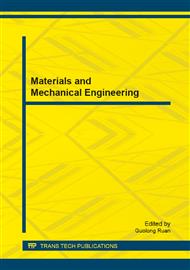[1]
N. Fang, P. Srinivasa Pai, N. Edwards, A comparative study of high-speed machining of Ti–Al – 4V and Inconel 718 - part I: effect of dynamic tool edge wear on cutting forces, The International Journal of Advanced Manufacturing Technology. 68 (2013).
DOI: 10.1007/s00170-013-4981-2
Google Scholar
[2]
R. Dubovska, J. Majerik, I. Baska, Experimental measurement of Cutting Forces in the Turning technology, DAAAM International Scientific Book, 11 (2012) 255-266.
DOI: 10.2507/daaam.scibook.2012.22
Google Scholar
[3]
H.K. Akyildiz, Evaluating of cutting forces in thread machining, The International Journal of Advanced Manufacturing Technology. 68 (2013) 1601-1612.
DOI: 10.1007/s00170-013-4957-2
Google Scholar
[4]
J. P. Davim, Machining of Hard Materials, first ed., Springer-Verlag-Limited, London, (2011).
Google Scholar
[5]
L. Qian, M. R. Hossan, Effect on cutting force in turning hardened tool steels with cubic boron nitride inserts, Journal of Materials Processing Technology, 191 (2007) 274-278.
DOI: 10.1016/j.jmatprotec.2007.03.022
Google Scholar
[6]
J. Wang, The effect of the multi-layer surface coating of carbide inserts on the cutting forces in turning operations, Journal of Materials Processing Technology. 97 (2000) 114-119.
DOI: 10.1016/s0924-0136(99)00353-2
Google Scholar
[7]
M. P. Groover, Fundamentals of Modern Manufacturing, Materials, Processes and Systems, third ed., John Wiley & Sons, Boston, (2007).
Google Scholar
[8]
M. Madaj, M. Piska, On the SPH Orthogonal Cutting Simulation of A2024-T351 Alloy, Procedia CIRP. 8 (2013) 152-157.
DOI: 10.1016/j.procir.2013.06.081
Google Scholar
[9]
H. Xinfeng, W. Su, H. Kratz, Forces in Hard Turning of 51CrV4 with Wiper Cutting Tool, Tsinghua Science and Technology. 11 (2006) 501-506.
DOI: 10.1016/s1007-0214(06)70226-7
Google Scholar
[10]
J. Majerik, Z. Jamrichova, M. Dobrikova, The verification of axial forces and torques in drilling by the noncoated cutting tools and drills with the PVD TiN coating, Annals of DAAAM for 2012&Proceedings-World Symposium Intelligent Manufacturing&Automation, 23 (2012).
DOI: 10.2507/23rd.daaam.proceedings.111
Google Scholar
[11]
F. Klocke, K. Geschwiller. Size effect of micro drilling in steel, Production Engineering, 3 (2009) 69-72.
Google Scholar
[12]
O. Kienzle, H. Victor. Spezifische Schnittkrafte bei der Metallbearbeitung, Werkstoff technik und Machinenbau, 47 (1957) 224-225.
Google Scholar
[13]
M. Gunay, U. Seker, G. Sur. Design and construction of a dynamometer to evaluate the influence of cutting tool rake angle on cutting forces, Materials & Design, 27 (2006) 1097-1101.
DOI: 10.1016/j.matdes.2005.04.003
Google Scholar
[14]
S. Yialdiz, F. Űnsacar. A dynamometer design for measurement the cutting forces on turning, Measurement, 39 (2006) 80-89.
DOI: 10.1016/j.measurement.2005.07.008
Google Scholar
[15]
Kistler Instrument Corp, High resolutions measurement of force, torque and strains, US, (2004).
Google Scholar
[16]
J. Paro, H. Hänninen, V. Kaupinnen, Tool wear and machinability of X5CrMn18 stainless steel, Journal of Materials Processing Technology, 119 (2001) 14-20.
DOI: 10.1016/s0924-0136(01)00877-9
Google Scholar
[17]
J. Jambor, Improving the quality of the machining process through new technologies, Annals of DAAAM for 2012 & Proceedings - World Symposium Intelligent Manufacturing & Automation, 23 (2012) 623-626.
DOI: 10.2507/23rd.daaam.proceedings.146
Google Scholar


